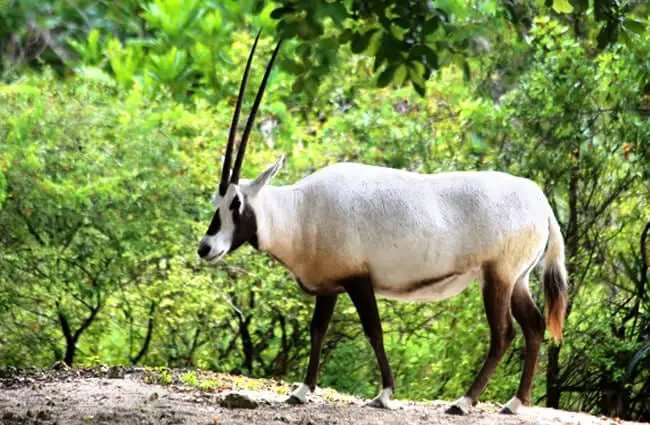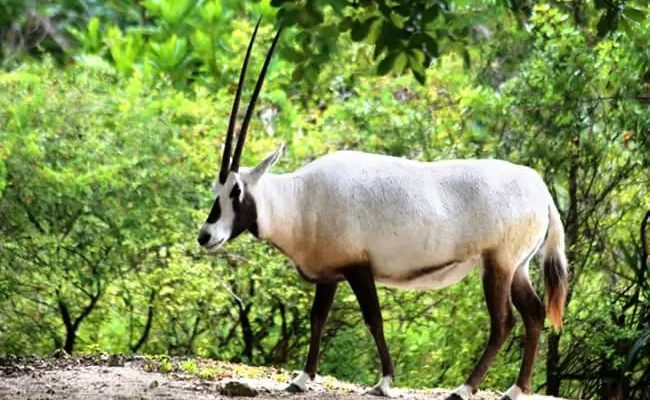
Oryxes are fascinating creatures, known for their striking appearance with long, straight horns and a sleek body built for endurance. Their adaptations are like nature’s own survival kit, equipped with everything they need to beat the odds. Let’s take a closer look at how these incredible animals manage to thrive where many others would struggle.
Adaptations to Extreme Heat
To put it simply, oryxes are built for hot weather. Their bodies are designed to handle extreme temperatures without breaking a sweat—literally. You see, these animals can withstand temperatures up to about 120°F. One of their clever tricks is their ability to elevate their body temperature during the hottest parts of the day. By doing this, they can minimize sweating and conserve precious water. It’s like wearing a cozy sweater in the heat, allowing them to avoid feeling too hot while still protecting themselves from overheating.
Additionally, oryxes have a special set of adaptations that help them manage their water needs. They can go for long stretches without drinking. In fact, they can get enough moisture from the plants they eat. When the sun is blazing, they seek shade and rest to avoid the heat, which is similar to how we might look for a cool spot on a hot summer day.
Water Conservation Techniques
Water is a precious resource in the desert, and oryxes have some clever strategies for making the most of it. Like smart planners, they know that every drop counts. One of their survival tactics is their ability to recover moisture from the plants they consume. They primarily eat dry grasses and desert shrubs, which might not seem like much, but they provide enough water to keep the oryx going.
Moreover, oryxes have adapted their kidneys to be super efficient. These organs can process water so well that they hardly lose any through urine. Imagine if you could drink a cup of water, and it could last you for days! This ability allows oryxes to stay hydrated even when water is virtually nonexistent.
Dietary Adaptations
Speaking of food, the diet of an oryx is as fascinating as their survival tactics. In their harsh environments, they have become highly selective eaters. They favor tough, dry vegetation, which might not be many animals’ first choice. However, those spiny desert plants provide the nutrients they need to thrive.
In addition to being picky about their food, oryxes are also great at finding it. They have excellent eyesight, which helps them spot vegetation from afar, even in the vast and barren landscape. With their keen sense of sight, they can locate green patches or shrubs that most other creatures would overlook.
Social Behavior and Herd Dynamics
Now, let’s talk about their social life. Oryxes are generally social animals, often forming small herds. This group dynamic offers some safety against predators, like lions or hyenas. There’s strength in numbers, and being part of a herd means they can keep watch for danger while also helping each other find food and water.
Interestingly, male and female oryxes can be found together in herds, especially during breeding season. This time of year can be especially tough, as food becomes even scarcer, and competition rises. By sticking together, they can share resources and support one another, making survival just a bit easier.
Behavioral Adaptations
Oryxes are not just about physical adaptations; they also exhibit interesting behavioral strategies that help them cope with their environment. For instance, they are crepuscular, meaning they are most active during the cooler times of the day, like early mornings and late afternoons. This behavior reduces their exposure to the intense midday heat, much like how we prefer to run errands during the cooler hours of the morning or evening.
They also migrate in search of food and water, following seasonal patterns. If a particular area becomes too dry, they are not afraid to pack up and head somewhere else. This kind of adaptability is crucial for survival in a landscape where the conditions can change rapidly.
Impact of Climate Change
Despite their amazing adaptations, oryxes still face challenges, especially in our changing climate. As temperatures rise and rainfall patterns shift, these animals must navigate an even harsher environment. Their ability to find food and water may be compromised, leading to increased stress on their populations.
Unfortunately, this is not just an issue for oryxes; many species are struggling to adapt to climate change. It’s a reminder of how interconnected everything is, and how we all play a part in conserving the delicate ecosystems that support wildlife. Every effort made to protect habitats, like reducing carbon footprints or supporting conservation initiatives, can help these incredible creatures continue to thrive.
The Future of Oryx Survival
Looking ahead, the future of oryx survival depends on both their remarkable adaptability and our commitment to preserving their habitats. Conservation efforts are essential in ensuring that these animals have enough space to roam, ample food sources, and access to water. Organizations working on wildlife conservation play a crucial role in protecting these habitats, ensuring that future generations can witness the beauty of oryxes in the wild.
As we learn more about how oryxes survive in harsh environments, we are reminded of the resilience of nature. These animals have thrived for centuries against the odds, and with the right support, they can continue to do so for years to come. There’s something quite inspiring about their ability to adapt and flourish, even when the odds are stacked against them.
In conclusion, oryxes teach us valuable lessons about resilience, adaptability, and the importance of caring for our planet. Understanding these beautiful creatures not only highlights their unique survival strategies but also reinforces the significance of conservation efforts. So the next time you think about survival in tough places, remember the oryx and its incredible journey through the deserts of our world.

